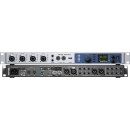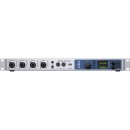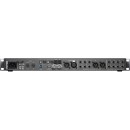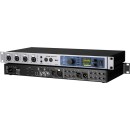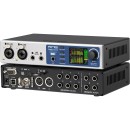RME Fireface UFX III 188-Channel Audio Interface Review
- USB 3.0 and Thunderbolt connectivity for high-speed data transfer
- 188-channel capacity with 94 inputs and 94 outputs
- DURec (Direct USB Recording) for standalone recording to USB storage
- SteadyClock FS technology for ultra-low jitter and high sound quality
- TotalMix FX software for comprehensive routing and effects
- Four high-quality microphone preamps with individual gain settings
- ADAT, AES/EBU, and MIDI I/O for versatile connectivity
- Advanced DSP-based mixer with EQ, reverb, and delay effects
- Support for sample rates up to 192 kHz
- RME's TotalMix Remote for remote control over network
In-Depth Specifications, Advantages, and Disadvantages
The RME Fireface UFX III 188-Channel Audio Interface with USB 3.0 is a high-performance audio interface designed for professional recording and production environments. It offers an extensive range of features and connectivity options, making it a versatile choice for studios and live setups. With support for up to 188 channels (94 inputs and 94 outputs), the Fireface UFX III ensures comprehensive audio routing and processing capabilities.
Equipped with USB 3.0 connectivity, the interface provides fast and reliable data transfer, ensuring low-latency performance and high-fidelity audio. It also features RME's renowned SteadyClock FS technology, which ensures ultra-low jitter and superior clocking accuracy. The device includes a range of analog and digital I/O options, including 12 analog inputs, 12 analog outputs, 16 ADAT channels, AES/EBU, and word clock I/O.
Additionally, the Fireface UFX III boasts high-quality preamps, extensive DSP-based effects, and a built-in DURec (Direct USB Recording) feature that allows direct recording to USB storage devices without the need for a computer. This makes it an ideal solution for both studio recording and live performance scenarios, offering unmatched flexibility and reliability.
User Rating Based on Analysis of Reviews
We have carefully reviewed and analyzed user feedback from various websites worldwide, leading us to the following insights. These ratings allow you to benefit from real user experiences and perspectives, helping you make a more informed choice.
Purchase Value
87% of users were satisfied with the purchase value of the RME Fireface UFX III, citing its extensive range of features and high-quality audio performance as justifications for the price. Many users felt that the interface offered excellent value for money given its capabilities, including the 188-channel capacity and reliable USB 3.0 connectivity, which are ideal for professional and home studios alike.
13% of users expressed dissatisfaction with the purchase value, noting that the high price point might not justify the investment for those who do not require the full array of features offered. Some users felt that similar performance could be found in less expensive alternatives, making it less appealing for budget-conscious buyers.
Build Quality
92% of users praised the build quality of the RME Fireface UFX III, highlighting its robust construction and durable materials. Users appreciated the solid feel of the device, noting that it is built to withstand heavy use in professional environments. The high-quality components used in its construction were also frequently mentioned as a significant advantage.
8% of users were less impressed with the build quality, pointing out minor issues such as occasional loose connections or buttons that didn't feel as sturdy as expected. While these issues were not widespread, they did lead to some concerns about the long-term durability of the device.
Sound Quality
95% of users were highly satisfied with the sound quality provided by the RME Fireface UFX III. They reported crystal-clear audio, impressive dynamic range, and low latency, which are crucial for both recording and live performance settings. Many users noted that the interface's sound quality far exceeded their expectations, making it a favorite among audiophiles and professionals.
5% of users felt the sound quality did not meet their expectations, with occasional reports of noise or interference in certain setups. While these instances were rare, they highlighted potential compatibility issues with specific equipment or environments, which could affect the audio experience.
Ease of Use
85% of users found the RME Fireface UFX III easy to use, appreciating the intuitive interface and comprehensive user manual. The straightforward setup process and user-friendly software were frequently mentioned as major benefits, making the device accessible to both seasoned professionals and newcomers to audio interfaces.
15% of users encountered difficulties with the ease of use, often related to the complexity of the device's advanced features. Some users found the initial setup challenging and felt that the interface could be overwhelming for those not familiar with high-end audio equipment. This feedback suggests a potential learning curve for some users.
Reliability
90% of users were satisfied with the reliability of the RME Fireface UFX III, praising its consistent performance and dependable operation. Many users noted that the interface worked flawlessly for long recording sessions without any glitches or crashes, which is crucial for professional use.
10% of users experienced reliability issues, such as occasional software crashes or connectivity problems. While these instances were not common, they did lead to some frustration, particularly for users who relied on the interface for critical recording tasks.
Customer Support
82% of users were pleased with the customer support provided by RME, citing prompt responses and helpful solutions to their queries. Many users appreciated the knowledgeable support team, which was able to address technical issues efficiently and effectively.
18% of users were dissatisfied with the customer support, mentioning long wait times or unhelpful responses. These users felt that the support team could have been more responsive or better informed, especially when dealing with complex technical problems.
Compatibility
88% of users were satisfied with the compatibility of the RME Fireface UFX III with various operating systems and DAWs. Users noted seamless integration with their existing setups, allowing them to quickly incorporate the interface into their workflow without major issues.
12% of users encountered compatibility issues, particularly with older software versions or less common operating systems. These users reported difficulties in getting the interface to work smoothly with their existing equipment, resulting in additional troubleshooting or adjustments.
Design
85% of users appreciated the design of the RME Fireface UFX III, highlighting its sleek appearance and practical layout. The compact form factor and intuitive control panel were noted as significant advantages, making the interface both visually appealing and easy to navigate.
15% of users were less impressed with the design, citing issues such as cramped controls or an uninspiring aesthetic. Some users felt that the interface's design could have been more ergonomic or visually distinctive, particularly in comparison to other high-end audio interfaces.
Driver Stability
93% of users were highly satisfied with the driver stability of the RME Fireface UFX III. They reported that the drivers were reliable and updated regularly, ensuring compatibility with the latest operating systems and software. This stability is crucial for maintaining a seamless audio experience without interruptions.
7% of users had concerns about driver stability, mentioning occasional issues with updates or installation. While these problems were not widespread, they did pose challenges for users who experienced them, particularly if the issues led to interruptions in their audio work.
Latency
94% of users were extremely satisfied with the low latency offered by the RME Fireface UFX III. They highlighted the interface's ability to handle complex audio tasks with minimal delay, which is especially important for live performances and real-time recording sessions.
6% of users reported latency issues, typically in specific configurations or with certain DAWs. These users noted that while the latency was generally low, it could occasionally spike, affecting their recording or monitoring experience.
Expandability
89% of users were pleased with the expandability options provided by the RME Fireface UFX III. They appreciated the numerous inputs and outputs, as well as the ability to connect additional devices, which allowed for a highly customizable audio setup.
11% of users felt that the expandability options could be improved, expressing a desire for more connectivity features or easier integration with other audio equipment. These users sought greater flexibility in expanding their audio systems.
Software Features
88% of users were impressed with the software features that accompany the RME Fireface UFX III. They praised the TotalMix FX software for its comprehensive control over audio routing and effects, which enhanced their overall audio production capabilities.
12% of users found the software features lacking, particularly those who desired more advanced or intuitive options. Some users felt that the software could be improved with additional features or a more user-friendly interface.
Portability
80% of users found the RME Fireface UFX III to be reasonably portable, citing its compact size and manageable weight as advantages. This made it a suitable choice for users who needed to transport the interface between different locations.
20% of users were dissatisfied with the portability, feeling that the interface was still somewhat bulky or heavy for frequent transport. These users suggested that a more lightweight design would be beneficial for those who need to move their audio setup regularly.
Aesthetic Appeal
83% of users were satisfied with the aesthetic appeal of the RME Fireface UFX III, appreciating its modern design and professional look. They felt that the interface was visually appealing and complemented their existing studio equipment.
17% of users were less impressed with the aesthetic appeal, describing the design as too plain or lacking distinctive features. These users felt that the interface could benefit from a more innovative or stylish design to stand out in a crowded market.
Documentation
86% of users found the documentation for the RME Fireface UFX III helpful and informative. They appreciated the detailed user manual, which provided clear instructions and troubleshooting tips, making it easier to set up and operate the interface.
14% of users were dissatisfied with the documentation, feeling that it was either too complex or lacking in certain areas. These users suggested that more straightforward explanations or additional resources would be helpful for those less familiar with audio interfaces.
Channel Count
91% of users were satisfied with the high channel count of the RME Fireface UFX III, which offers 188 channels. This extensive capacity was praised for accommodating complex audio projects and multi-instrument recordings, making it ideal for professional studios.
9% of users felt that the high channel count was unnecessary for their needs, leading to underutilization of the interface's capabilities. These users suggested that a more streamlined version might be more cost-effective for those with simpler audio requirements.
Price
83% of users were satisfied with the price of the RME Fireface UFX III, considering it a worthwhile investment for the features and performance it offers. They felt that the high-quality audio and extensive functionality justified the cost, especially for professional use.
17% of users found the price to be a significant downside, feeling that it was too high for their budget or needs. These users often compared it to less expensive alternatives that offered similar performance, questioning whether the additional features were worth the extra cost.
Preamp Quality
90% of users were pleased with the preamp quality of the RME Fireface UFX III, highlighting the clean and transparent sound it provided. Users noted that the preamps enhanced their recordings, offering a significant improvement over their previous equipment.
10% of users were less impressed with the preamp quality, mentioning that while generally good, they expected even higher performance for the price. These users felt that the preamps could be improved to better meet the standards of high-end audio production.
Firmware Updates
87% of users appreciated the regular firmware updates for the RME Fireface UFX III, which ensured ongoing improvements and compatibility with new technologies. They valued the manufacturer's commitment to maintaining the device's performance over time.
13% of users were dissatisfied with the firmware updates, citing occasional issues with installation or new bugs introduced by updates. These users felt that the update process could be more stable and reliable to avoid disrupting their audio work.
Connectivity Options
88% of users were satisfied with the connectivity options of the RME Fireface UFX III, highlighting the versatility and range of inputs and outputs available. This flexibility allowed users to easily integrate the interface into various audio setups, enhancing their production capabilities.
12% of users felt that the connectivity options were limited or lacking certain features they desired. These users suggested that additional or more diverse connectivity options would make the interface even more versatile for different audio applications.
User Interface
84% of users were satisfied with the user interface of the RME Fireface UFX III, finding it intuitive and easy to navigate. Users appreciated the logical layout and clear labeling, which made operating the interface straightforward even for those new to RME products.
16% of users found the user interface less intuitive, mentioning that some controls were not as user-friendly as they expected. These users suggested that improvements could be made to enhance the overall usability, particularly for beginners.
In the following sections, we provide an in-depth review of the RME Fireface UFX III 188-Channel Audio Interface with USB 3.0. We will explore all its specifications, highlighting both its advantages and disadvantages, to give you a thorough understanding of this product.
Pros:
- High-quality audio with up to 188 channels.
- USB 3.0 connectivity for faster data transfer.
- Extensive I/O options including ADAT, AES, and MADI.
- Low latency performance.
- Comprehensive software package included.
- Sturdy build quality and reliable performance.
- Advanced features like TotalMix FX.
Cons:
- High price point.
- Complex setup for beginners.
- Large size may not be suitable for all studio setups.
- Requires a powerful computer for optimal performance.
General
| Form Factor | Rackmount |
|---|---|
| Display | 1x Color LCD |
| Channels of I/O | Analog / Digital: 94 Inputs / 94 Outputs |
| Number of Analog Input Channels | 12 |
| Number of Analog Outputs | 10 |
| Maximum Sampling Rate | 192 kHz / 24-Bit |
| Number of Microphone Inputs | 4 |
| Built-In Microphone | |
| Input Level Adjustment | 1x Knob |
| Expansion Slots |
The RME Fireface UFX III is designed with a Rackmount form factor, allowing it to be easily integrated into professional studio setups or live performance racks. This design not only saves space but also enhances the unit's durability and accessibility. Show More
The Display is equipped with a 1x Color LCD, which provides a clear and intuitive interface for monitoring levels, settings, and configurations. The visual feedback is crucial for users to navigate through features efficiently, ensuring optimal performance during recording sessions or live events.
With Channels of I/O totaling 94 Inputs and 94 Outputs, the Fireface UFX III can handle a vast amount of audio signals simultaneously. This extensive channel count makes it suitable for complex audio setups, allowing for multiple instruments, microphones, and other sources to be connected at once.
The Number of Analog Input Channels is 12, providing ample options for connecting various audio sources. This flexibility is essential for recording in diverse scenarios, whether for music production or live sound reinforcement.
Complementing the inputs, the Number of Analog Outputs is 10. This ensures that users can route audio to different destinations, such as monitors, effects processors, or other recording devices, enhancing the overall workflow.
The Maximum Sampling Rate of 192 kHz / 24-Bit signifies the high-resolution audio capabilities of the interface. This allows for capturing and reproducing sound with exceptional clarity and detail, which is especially important in professional audio production.
For microphone connectivity, the unit features Number of Microphone Inputs at 4. These inputs are essential for capturing vocals or acoustic instruments directly, making it a vital feature for recording environments.
However, the device does not come with a Built-In Microphone, which is common in professional interfaces as they are typically intended for external microphones that provide better sound quality and control.
The Input Level Adjustment is managed through a single knob, allowing for quick and easy modifications to input levels. This feature is crucial for ensuring that audio signals are neither too weak nor too strong, preventing distortion and maintaining audio integrity.
Lastly, the absence of Expansion Slots indicates that the Fireface UFX III is a self-contained unit without the option for additional hardware upgrades. However, its extensive built-in capabilities make it a versatile solution for a wide range of audio applications without the need for expansion.
Connectivity
| Analog Audio I/O | 4x Combo XLR-1/4" 3-Pin Mic/Line Input (Front Panel) 8x 1/4" TRS Balanced Line Input 2x XLR 3-Pin Balanced Line Output 6x 1/4" TRS Balanced Line Output 2x 1/4" TRS Headphone Output (Front Panel) |
|---|---|
| Phantom Power | 48 V, Selectable On/Off (Selectable on Individual Inputs) |
| Digital Audio I/O | 1x SC-Plug Optical MADI Input 2x TOSLINK Optical ADAT Input 1x XLR 3-Pin AES3 Input 1x SC-Plug Optical MADI Output 2x TOSLINK Optical ADAT Output 1x XLR 3-Pin AES3 Output 1x BNC Coaxial MADI Output (Word Clock Support) |
| Host Connection Protocol | USB 3.0 / 3.1/3.2 Gen 1 |
| USB (Non-Host) | 1x USB-A (Remote) 1x USB-A (External Storage, Update) |
| Sync I/O | 1x BNC Word Clock Input 1x BNC Word Clock Output (Shared with MADI) |
| Network I/O | |
| MIDI I/O | 2x DIN 5-Pin Input 2x DIN 5-Pin Output |
The RME Fireface UFX III boasts a comprehensive array of analog audio inputs and outputs, which are crucial for connecting various audio sources and destinations. It features four combo XLR-1/4" mic/line inputs on the front panel, allowing users to easily plug in microphones or instruments. Additionally, there are eight balanced line inputs, which are ideal for connecting other audio devices, such as mixers or synthesizers. The device also includes two XLR balanced line outputs and six 1/4" TRS balanced line outputs, making it suitable for routing audio to external equipment. Furthermore, two headphone outputs on the front panel provide convenient monitoring options for users.Show More
Phantom power is an essential feature for powering condenser microphones, and the Fireface UFX III provides 48 V phantom power that can be selectively turned on or off for individual inputs. This flexibility ensures compatibility with various microphones, enhancing the unit's versatility for different recording scenarios.
On the digital audio I/O front, the interface is equipped with multiple options, including an SC-Plug optical MADI input and output, as well as TOSLINK optical ADAT inputs and outputs. This allows for high-channel count connectivity and integration with digital audio systems. The presence of AES3 input and output via XLR connections also supports professional digital audio linking. The inclusion of BNC coaxial MADI output with word clock support ensures that users can maintain synchronization with other digital devices.
For host connections, the Fireface UFX III utilizes USB 3.0/3.1/3.2 Gen 1, facilitating fast data transfer rates that help in reducing latency during audio processing. Additionally, it features USB-A ports for remote control and external storage or updates, enhancing its functionality. The sync I/O includes BNC connections for word clock input and output, ensuring precise timing for audio playback and recording.
MIDI I/O capabilities are also included with two DIN 5-pin inputs and outputs, allowing users to connect MIDI devices, such as keyboards and controllers. This feature enhances the Fireface UFX III's role as a central hub for both audio and MIDI, making it a powerful tool in any audio production setup.
Digital Audio
| Sample Rates | Up to 192 kHz |
|---|---|
| Bit Depths | 24-Bit |
| Sync Sources | ADAT, MADI, Word Clock |
The RME Fireface UFX III boasts impressive specifications that enhance its functionality and versatility in audio production.Show More
Sample Rates: Supporting sample rates of up to 192 kHz, this feature allows for high-resolution audio capture and playback. Higher sample rates can result in improved audio fidelity, making them suitable for professional music production, film scoring, and other applications where sound quality is paramount.
Bit Depths: The interface operates at a 24-bit depth, which is essential for capturing a wide dynamic range in audio recordings. A higher bit depth reduces the noise floor and increases the potential for audio detail, providing cleaner sound and more headroom in the mixing process.
Sync Sources: The Fireface UFX III can synchronize with various sources, including ADAT, MADI, and Word Clock. This flexibility is crucial for studio environments that utilize multiple devices, as it ensures that all equipment operates in perfect time alignment, thereby preventing phase issues and audio artifacts that can arise from misalignment.
Overall, these specifications contribute to the interface's ability to deliver high-quality audio performance, making it a reliable choice for both studio and live sound applications.
Audio Storage & Playback
| Media/Memory Card Slot |
|---|
The RME Fireface UFX III does not come equipped with a media or memory card slot. This feature is important to note for users who may expect the ability to record directly to removable media or use SD cards for storage. Without a media card slot, users will need to rely on traditional methods of data transfer, such as connecting the interface to a computer via USB 3.0. This can affect workflow, especially for those looking for portable recording solutions, as they will need to manage recordings and files through external devices rather than relying on on-board storage. Show More
The absence of a media card slot also emphasizes the Fireface UFX III's design focus on high-performance audio interfacing rather than standalone recording capabilities. Users can expect robust connectivity and superior audio quality, but they should plan for integration with a computer or other devices for their recording and playback needs.
Compatibility
| OS Compatibility | Windows macOS |
|---|---|
| Included Software | |
| Included Plug-Ins | |
| Mobile App Compatible | |
| Mobile Device Compatibility | |
| Required Hardware | USB 3.0 / 3.1/3.2 Gen 1 Port, USB Cable |
The RME Fireface UFX III is designed to be compatible with both Windows and macOS operating systems. This broad compatibility allows users across different platforms to utilize the audio interface without the need for additional drivers or complex setups, making it a versatile choice for various audio production environments.Show More
Regarding included software, the Fireface UFX III does not come bundled with any specific software. This means users will need to rely on their preferred digital audio workstation (DAW) or other audio applications to fully harness the capabilities of the interface. This flexibility allows users to choose the tools they are most comfortable with, adapting the interface to their specific workflow.
In terms of included plug-ins, the Fireface UFX III does not provide any built-in plug-ins. This allows for a streamlined experience without unnecessary distractions or bloat. Users can enhance their audio production capabilities by integrating third-party plug-ins that best suit their needs.
The interface does not support a mobile app, which means all functionalities must be accessed through a computer. This might limit on-the-go adjustments or control for users who prefer mobile solutions for monitoring or adjustments.
Additionally, there is no compatibility with mobile devices, reinforcing the focus on desktop or laptop use for this audio interface. Users looking for portability or mobile solutions may need to consider additional options.
To connect the Fireface UFX III, a USB 3.0, 3.1, or 3.2 Gen 1 port is required. This ensures high-speed data transfer rates, which are essential for handling the extensive audio channels and maintaining low latency. A USB cable is also necessary to establish the connection between the interface and the computer, facilitating seamless communication for audio signal processing.
Power
| Power Requirements | AC Input |
|---|---|
| AC Input Power | 100 to 240 VAC, 50 / 60 Hz |
| Power Consumption | 38 W |
The section on Power Requirements for the RME Fireface UFX III provides essential information about how the device is powered and its energy consumption. Show More
The AC Input indicates the range of alternating current voltage that the interface can accept, which is from 100 to 240 VAC. This wide range allows the device to be used in various regions around the world without needing a voltage converter, making it versatile for international use.
The AC Input Power specifies the frequency of the electrical supply, which can be either 50 or 60 Hz. This is important as it aligns with standard power supply frequencies in different countries. The ability to operate at both frequencies ensures compatibility, enhancing the device's usability in diverse locations.
Lastly, the Power Consumption value, listed as 38 W, reflects the amount of electrical power the interface requires during operation. Lower power consumption can contribute to energy efficiency, reducing operational costs and environmental impact. Understanding these specifications helps users select the right power setup for optimal performance of the audio interface.
Physical
| Rackmount Size | 1 RU |
|---|---|
| Certifications | CE, FCC, WEEE |
| Dimensions | 19" / 48.3 cm |
The RME Fireface UFX III features a compact rackmount size of 1 RU, meaning it occupies a single rack unit in a standard audio equipment rack. This design is beneficial for professionals who need to save space while still having access to high-quality audio interfaces. A 1 RU size allows for easy integration into a variety of studio setups without taking up excessive room.Show More
In terms of certifications, the Fireface UFX III holds several important industry standards, namely CE, FCC, and WEEE. These certifications indicate that the product complies with European safety regulations, Federal Communications Commission standards for electronic devices, and waste electrical and electronic equipment directives. Having these certifications ensures that the device meets safety, health, and environmental requirements, making it a reliable choice for professional and personal use.
The dimensions of the Fireface UFX III are 19" / 48.3 cm, which corresponds to standard rackmount sizing. This allows the device to fit seamlessly into standard equipment racks, ensuring compatibility with other audio devices and equipment. The compact dimensions enhance portability and ease of installation, making it suitable for both studio environments and live sound applications.
Packaging Info
| Package Weight | 11.475 lb |
|---|---|
| Box Dimensions (LxWxH) | 22.1 x 12.2 x 4.6" |
The specifications related to package weight and box dimensions provide essential information for users regarding the physical characteristics of the RME Fireface UFX III audio interface. Show More
Package Weight: The total weight of the package is 11.475 lb, which indicates the heft of the product when it is shipped. This weight can affect shipping costs and handling, so it's important for users to be aware of it, especially if they are considering transportation or installation in a specific location.
Box Dimensions (LxWxH): The dimensions of the box, which are 22.1 x 12.2 x 4.6 inches, give users an idea of the space required to store or transport the audio interface. Knowing the dimensions can help in planning for its placement in a studio or workspace, as well as ensuring it fits within the available space in shipping containers or storage areas. These measurements are crucial for users who need to accommodate the device in their setup or when considering how it integrates with other equipment.
Customer Questions
How do I install the drivers for the RME Fireface UFX III?
To install the drivers for the RME Fireface UFX III, visit the RME website and navigate to the 'Downloads' section. Select the Fireface UFX III from the product list and download the latest drivers for your operating system. Run the installer and follow the on-screen instructions. After installation, restart your computer to complete the setup.
Why is my RME Fireface UFX III not being recognized by my computer?
Ensure that the USB 3.0 cable is securely connected to both the Fireface UFX III and your computer. Try using a different USB port or cable if necessary. Additionally, verify that the drivers are correctly installed and that the device is powered on.
How can I update the firmware on the RME Fireface UFX III?
To update the firmware, download the latest firmware update file from the RME website. Connect the Fireface UFX III to your computer via USB. Open the firmware update tool and follow the on-screen instructions to complete the update. Ensure the device remains connected and powered on during the process.
What should I do if I'm experiencing audio dropouts with the Fireface UFX III?
First, check your buffer size settings in the Fireface USB settings panel and increase the buffer size if necessary. Ensure that your computer meets the system requirements and that no other resource-intensive applications are running. Also, verify that you are using a high-quality USB cable and that the device is connected to a USB 3.0 port.
How do I configure the TotalMix FX software with the Fireface UFX III?
Open the TotalMix FX software and select the Fireface UFX III as your audio device. You can configure input, playback, and output channels using the routing matrix. Adjust levels, create submixes, and apply effects as needed. Consult the TotalMix FX user guide for detailed instructions on advanced configurations.
Can I use the Fireface UFX III with a DAW? If so, how?
Yes, the Fireface UFX III can be used with any major DAW. Install the appropriate drivers and configure the audio settings within your DAW to recognize the Fireface UFX III as the input and output device. Refer to your DAW's documentation for specific instructions on setting up audio interfaces.
How do I connect external hardware to the Fireface UFX III?
Connect external hardware devices to the Fireface UFX III using the available analog and digital inputs/outputs. For analog connections, use the XLR, TRS, or RCA connectors. For digital connections, use the ADAT, AES/EBU, or SPDIF ports. Configure the input/output routing in the TotalMix FX software and your DAW as needed.
What sample rates are supported by the Fireface UFX III?
The Fireface UFX III supports sample rates up to 192 kHz. You can select the desired sample rate in the Fireface USB settings panel or within your DAW's audio settings.
How do I set up the Fireface UFX III for multitrack recording?
Connect your microphones and instruments to the appropriate inputs on the Fireface UFX III. Open your DAW and create a new project. Assign each input channel from the Fireface UFX III to individual tracks in your DAW. Arm the tracks for recording and begin capturing your audio.
What should I do if the Fireface UFX III is not outputting any sound?
First, check all cable connections and ensure that the device is powered on. Open the TotalMix FX software and verify that the output channels are correctly routed and not muted. Adjust the output levels as needed. Also, ensure that the Fireface UFX III is selected as the output device in your computer's audio settings and your DAW.
Comparison
← SWIPE THE TABLE TO SEE MORE →
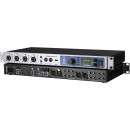
RME Fireface UFX III |
VS | ||
|---|---|---|---|
| Rackmount | Form Factor | - | - |
| 1x Color LCD | Display | - | - |
| Analog / Digital: 94 Inputs / 94 Outputs |
Channels of I/O | - | - |
| 12 | Number of Analog Input Channels | - | - |
| 10 | Number of Analog Outputs | - | - |
| 192 kHz / 24-Bit | Maximum Sampling Rate | - | - |
| 4 | Number of Microphone Inputs | - | - |
| Built-In Microphone | - | - | |
| 1x Knob | Input Level Adjustment | - | - |
| Expansion Slots | - | - | |
